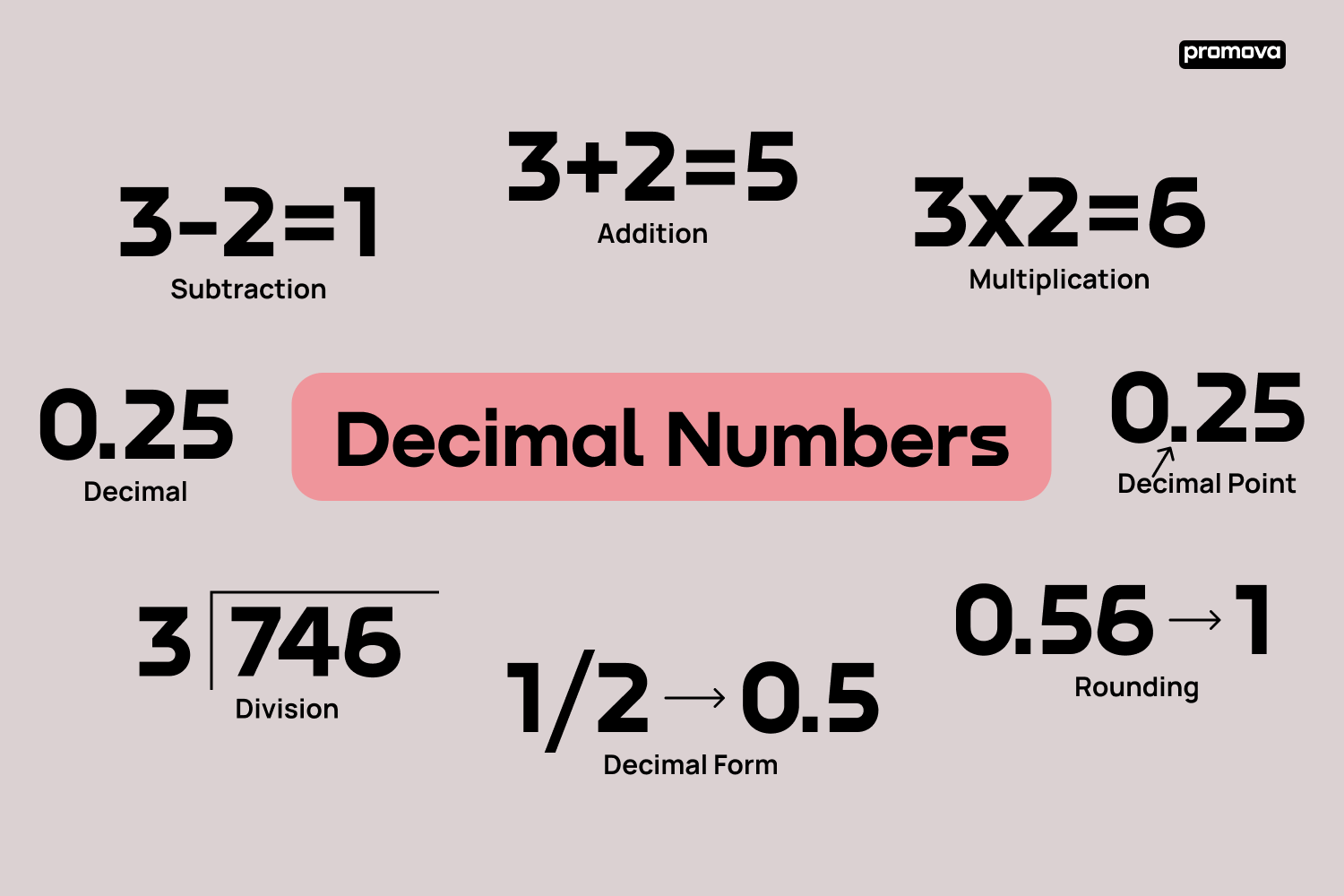Vocabulary of Decimal Numbers
Contents
Whether you're a student on a knowledge quest, a teacher, or simply learning the English language, this guide to decimal numbers is your secret map. 
What Is a Decimal Number?
A decimal number is a number that includes a decimal point, which separates the whole number part from the fractional part. A decimal number can represent whole numbers, fractions, and mixed numbers. For instance, the number 2.75 is a decimal number, representing two and three-quarters.
Basic Decimal Terminology
Before you delve deeper into the decimal world, let's get familiar with some fundamental terms:
- Decimal: A number expressed in the base-ten system. Example: 0.25, which you read as "zero point two five".
- Decimal Point: A dot used to separate the whole number from the fraction in a decimal number. Example: In 3.14, the decimal point separates 3 and 14.
- Whole Number Part: The part of the decimal to the left of the decimal point. Example: In 7.89, 7 is the whole number part.
- Fractional Part: The part of the decimal to the right of the decimal point. Example: In 7.89, 89 is the fractional part.
- Decimal Place: The position of a number after the decimal point. Example: In 0.123, 1 is in the first decimal place, 2 is in the second, and 3 is in the third.
- Ones: The "ones" place is the first place to the left of the decimal point in a number, and it represents whole numbers from 0 to 9.
- Tens: The "tens" place is the second place to the left of the decimal point in a number, and it represents multiples of 10.
- Tenths: The first digit after the decimal point.
- Hundreds: The second digit after the decimal point.
- Thousands: The third digit after the decimal point.
- Rounding: The process of approximating a number to the nearest whole number or decimal place. Example: 0.56 rounded to the nearest whole number is 1.
Mastering basic decimal terminology is a significant achievement in your language learning. These words are key to understanding and discussing decimals in English. Remember, the more you use them, the more naturally they'll come to you.
Operations with Decimals
As you get comfortable with the decimal meaning, it's crucial to understand how you can perform operations with these numbers:
- Addition: A mathematical operation that combines two or more numbers, called addends, into a larger number, known as the sum.
- Subtraction: A mathematical operation that finds the difference between two numbers. The number from which another number is subtracted is called the minuend, and the number being subtracted is the subtrahend. The result of subtraction is called the difference.
- Multiplication: A mathematical operation that calculates the total of an item when repeated a certain number of times. The numbers being multiplied are called factors, and the result is the product.
- Division: A mathematical operation that breaks down a total quantity into equal parts. The number being divided is the dividend, the number dividing is the divisor, and the result is the quotient.
As you continue to practice operations with decimals, your comfort and speed will increase, making your mathematical communication in English more fluent and natural.
11
Decimal Conversions
Converting decimals to other number forms is a common operation. Here are some terms associated with this process:
- Decimal Form: The decimal equivalent of a fraction or whole number. Example: The decimal form of 1/2 is 0.5.
- Fractional Form: Converting a decimal into a fraction. Example: The fractional form of 0.25 is 1/4.
- Percentage Form: Converting a decimal into a percentage. Example: The percentage form of 0.20 is 20%.
With this knowledge, you can comfortably convert numbers between these different forms, an important skill when dealing with decimals. Whether you're reading a math problem or encountering these numbers in everyday life, you're equipped to handle them adeptly.
Types of Decimals
Lastly, it is vital to understand the difference between repeating and terminating decimals:
- Repeating/Recurring Decimal: A decimal that has a digit or a group of digits that repeats indefinitely. Example: 0.333... You read it as "zero point three repeating".
- Non-recurring Decimal: Decimal representations of rational numbers where the digits after the decimal point do not repeat infinitely; they continue without any repeating pattern. For example, 3/8 = 0.375 (Non-recurring decimal: The digits 3, 7, and 5 do not repeat)
- Terminating Decimal: A decimal that has a definite end. Example: 0.25. You read it as "zero point two five."
Understanding the concept of repeating and terminating decimals is a crucial step in your English language-learning journey. Now, you can recognize and describe these three types of decimals. You can read these decimals with confidence, knowing what each part signifies.
Conclusion
Decimals can be easy to understand if you know the terms and how to use them correctly. Now that you know what are decimal numbers, their basic terms, and how to perform various operations, you should feel more comfortable using them in English.
Comments